

Six Engaging End-of-Year Projects. I don't know about your students, but so many of mine, coupled with Senioritis, were done after state testing.

(The well had run dry, no blood from a turnip -- all those sayings applied!) With just a few precious weeks left in the school year, what do you do to keep the kids energized and on board with learning? One thing I knew for sure when it came to my high school students: They had to feel as if they weren't actually doing work. (Yep, I had to trick them.) And whatever you do plan, especially for secondary students, three elements are essential: choices, creativity, and constructing. Consider these projects (and I've included the cognitive demands): 1. Give students an opportunity to teach the rest of the class something, like origami, a new app, or a martial arts self-defense move (design, construct, apply). 2. 3. Have students take ownership of a planet, song, decade, career, author, country, scientist, medical breakthrough. . . 4. 5. 6. Integrated PBL Projects: A Full-Course Meal! In the project-based learning field, we use the metaphor that projects are the "main course, not the dessert" (as coined in an article from the Buck Institute for Education).
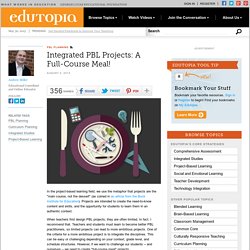
Projects are intended to create the need-to-know content and skills, and the opportunity for students to learn them in an authentic context. When teachers first design PBL projects, they are often limited. In fact, I recommend that. Teachers and students must learn to become better PBL practitioners, so limited projects can lead to more ambitious projects. One of the criteria for a more ambitious project is to integrate the disciplines. Teachers develop PBL curriculum for the coming year. Structuring Collaboration for Student Success (Keys to PBL Series Part 3)
Peggy: The teacher doesn’t just throw control to the students and say, "Let me know what you figure out.
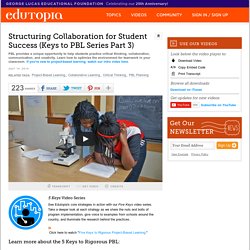
" She really has to plan ahead of time, she has to figure out how to group the students so that they're the most productive. She has to scaffold their work, so she provides hints or clues or templates, worksheets is necessary, to kinda show them what they need to do first, what they might consider doing next. She has to teach them how to work together. Teamwork is not something that comes naturally, especially for younger students. 10 Practical Ideas For Better Project-Based Learning In Your Classroom. By Jennifer Rita Nichols, TeachThought Intern Teachers are incorporating more and more projects into their curriculum, allowing for much greater levels of collaboration and responsibility for students at all levels.
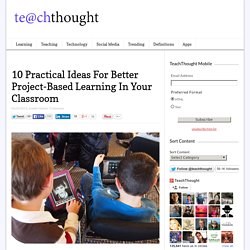
Project- based learning is a popular trend, and even teachers who don’t necessarily follow that approach still see the benefit to using projects to advance their students’ learning. Projects can be wonderful teaching tools. They can allow for a more student-centred environment, where teachers can guide students in their learning instead of using lectures to provide them with information. 4 Keys To Designing A Project-Based Learning Classroom - Traditional American classrooms tend to fit a particular mold: Students face the front of the class where teachers lecture.
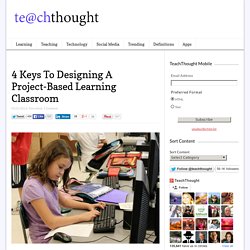
Students take notes, finish assignments at home, and hope to memorize enough information just long enough to pass a test. Engagement and passion are often in short supply — among students and teachers. The system does not necessarily accommodate all learning styles, and even those who fair well may be missing out on other important work-life lessons, like how to creatively solve problems, stay focused, work as part of a team, and organize their thoughts in a way others will understand. A World of Project Ideas (You Can Steal) One of the advantages of project-based learning is the flexibility.
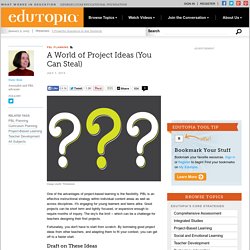
PBL is an effective instructional strategy within individual content areas as well as across disciplines. It's engaging for young learners and teens alike. Good projects can be short term and tightly focused, or expansive enough to require months of inquiry. The sky's the limit -- which can be a challenge for teachers designing their first projects. Fortunately, you don't have to start from scratch. Project Based Learning: Don’t Start with a Question. Do you have to start project-based learning (PBL) with a question?
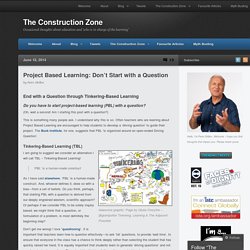
(Oh, wait a second! Am I starting this post with a question?) This is something many people ask. I understand why this is so. 3 Types Of Project-Based Learning Symbolize Its Evolution. Project-Based Learning is an increasingly popular trend in the 21st century.
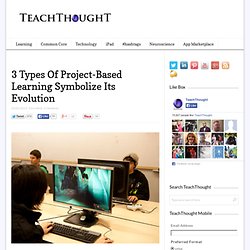
The best evidence for this popularity might be the nuance it’s taken on. Project-Based Learning has gone from academic study that yields end-of-unit projects, to highly complex methods of creating and publishing student thinking. It is more closely associated with 21st century learning skills than perhaps any other form of learning, and new technology in the classroom is improving its potential exponentially.
A World of Project Ideas (You Can Steal) 12 Timeless Project-Based Learning Resources. Classroom Guide: Top Ten Tips for Assessing Project-Based Learning (now available in Spanish!) Facebook Edutopia on Facebook Twitter.

What Does a Great School Year Look Like? Ask the Students. Teaching Strategies Shelley Wright Shelley Wright's class constructed a complete Holocaust Museum as part of a school project.

This past school year, Shelley Wright, a high school educator in Moose Jaw, Saskatchewan, made a number of big changes in her teaching practice. Integrated PBL Projects: A Full-Course Meal! Aprendizaje Basado en Proyectos ABP-PBL. PBL. Feedback, feed-forward, peer-assessment and project-based learning. Last year when I began my Masters of Ed, my lecturer told me that I should read about ‘feedback’. She encouraged me to look at the work of Black and Wiliam (Inside the Black Box being their most well known and eloquent paper on feedback and assessment), Hattie (his book Visible Learning on the effect sizes of a variety of teaching methods revealed ‘feedback’ has the most significant impact on learning) and Petty (who used the research of Hattie and made it practical for the classroom in his book ‘Evidence Based Teaching’). Project Based Learning. I’ve been teaching using a project-based learning pedagogy since mid-2010 when I was introduced to PBL by my friend, Dean Groom.
Since then I have had some wonderful learning experiences with PBL and I enjoy sharing both my successes and failures and experiments in learning on my blog. I thought it’d be helpful for other people if I put all of my PBL-related posts on one page, just in case you’re starting out and you want to see how another teacher is doing it too. If you have any questions, just post a comment below or send me a tweet on twitter My VERY first experience with PBL – and it was hard work and had serious issues! My post might help some of your PBL newbies feel less anxious, maybe! This is a reflection on my very first PBL experience with Year 10 – it looks at why it may not have been 100% successful. Interest in PBL from teachers in my local area really started happening at the beginning of 2011. Resources and Tools for PBL Start to Finish. Tips for downloading: PDF files can be viewed on a wide variety of platforms -- both as a browser plug-in or a stand-alone application -- with Adobe's free Acrobat Reader program.
Click here to download the latest version of Adobe Reader. Documents to Help You Get Started. Edutopia-10tips-assessing-project-based-learning.pdf. Metodología del ABP. Project-based Learning Framework - Teaching the Teacher. APRENDIZAJE POR PROYECTOS. Metodología del ABP. Free Classroom Guides and Educational Downloads. PBL Gallery. Home | Getting Started | Modules | Resources | About Us View the work of teachers who developed and implemented PBL units/mini-units.
Feel free to download and use the PBL as a template for your work with students. We appreciate your feedback. Five Keys to Rigorous Project-Based Learning. Voiceover: How will today’s children function in a dangerous world? What means will they use to carve the future? Will they be equipped to find the answers to tomorrow’s problems? Making Projects Click. Project Based Learning. Problem-Based Learning Project. Cómo empezar en el trabajo por proyectos.
En las aulas se están viviendo cambios y transformaciones que, entre otros aspectos, afectan a las metodologías de enseñanza. Una de las que más auge está teniendo es el trabajo por proyectos que permite al alumnado poner en práctica sus conocimientos de manera autónoma, involucrarse en su propio aprendizaje, tener una actitud más participativa… a partir de un proyecto de investigación o desarrollo ligado a unos objetivos concretos. De cara al próximo curso, la plataforma aulaPlaneta ha elaborado un listado con las claves que hay que tener en cuenta para poner en práctica esta metodología en el aula: 1. Elegir un proyecto motivador: El tema y el enfoque son importantes para que los estudiantes se involucren -el profesorado puede elegir entre una propuesta ya desarrollada o elaborar la suya propia-. 2. 3.Plantear un trabajo bien estructurado. Análisis, síntesis y evaluación.
Ventajas En cuanto a las ventajas más importantes del trabajo por proyectos, la plataforma indica las siguientes: 1. 15 documentos imprescindibles para alumnos que trabajan por proyectos. El proyecto EDIA recopila recursos que los alumnos necesitarán en distintas fases del trabajo por proyectos. También incluye otro elemento esencial: la autoevaluación del propio profesor. Los recursos facilitan el desarrollo de aspectos esenciales en la metodología ABP como la planificación del trabajo en equipo, la revisión del proceso de aprendizaje y la evaluación final del proyecto. Project Based Learning: Explained. What It Takes to Become an All Project-Based School. In many schools, project-based learning happens in isolated cases: in certain teachers’ classrooms here and there, or in the contexts of specific subjects.
Embracing Messy Learning. 5 PBL Best Practices for Redefining the Teacher's Role. "Fitting In" PBL. Regularly, teachers tell me that they don't feel as though they have time for project-based learning (PBL). While they like the idea in theory, they can't see a way to realistically "fit it in" with their curriculum given constraints of time, testing, standards, etc. What Project-Based Learning Is — and What It Isn’t. Screenshot/High Tech High. Using Google Tools in Project-Based Learning Infographic. Blogs on Project-Based Learning. What the Heck Is Project-Based Learning? Project-based Learning Framework - Teaching the Teacher. Twenty Tips for Managing Project-Based Learning. A Great Project Based Learning Checklist for Teachers.
Dare to Believe: Problem Based Learning with ICTs by Shelly Terrell on Prezi. Awesome Tools & Apps for Student Projects. How to Implement Problem Based Learning with ICTs. My Top Free Online Tools and Resources for PBL.